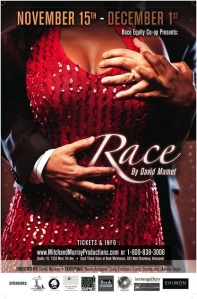Margery Williams’ original Velveteen Rabbit was published in 1922. Chris Craddock’s adaptation, first produced last year, makes the story work for modern sensibilities and builds in enough exposition of unfamiliar concepts and customs to allow contemporary children to follow the tale, by using the framing story of a Dad (Chris Craddock) reading the old book to his youngest child (Alyson Dicey), while answering her questions and talking about their family. “What’s the name of the Boy in the story?” the little girl asks, proposes her own name, suggests a few more changes “And there’s a robot, okay Dad?” and then leaps into acting it out. The scenes then alternate between the period story and the contemporary bedtime reading. The children’s ways of narrating and negotiating pretending games are spot-on, in the same way as the characters in Craddock’s Fringe 2012 play, “Apocalypse: A Period Piece” shifted seamlessly between making real plans and imagining themselves as Elvis, President Kennedy, and their father.
In the story, the Velveteen Rabbit and other non-human characters are appealing puppets (credited to Green Fools Theatre). Jamie Cavanagh’s Skin Horse was particularly expressive. Tatyana Rac as Nana, in white pinafore, showed her affection for the Boy and her own grief at having to dispose of the Velveteen Rabbit. I was a bit distracted by trying to figure out whether her accent was supposed to be from Belfast, Glasgow, or somewhere else, and then got wondering about the relative class marking of having an Irish or Scottish nanny.
In the bedtime reading, the little girl asks whether the Boy’s parents are dead like her own mother, or whether they’re not in the story because they don’t love him. The Dad explains that in those days the way loving parents took care of their kids was to hire a good Nana. The little girl asks what scarlet fever is, and begs her father never to burn her toys if she gets sick. The Dad reassures her that we have better ways of dealing with germs nowadays, and tries to slip into the story a line about washing your hands before meals.
You might remember that the happy ending of the book is that the toy, set aside to be incinerated because of germs, is magically reincarnated as a real flesh-and-blood rabbit to jump and dance with other rabbits forever. The real rabbit later has a brief encounter in the garden with an older Boy, who almost recognises him. I suppose that in that era, that’s one of the few positive ways of imagining a happy ending for a well-loved toy – although the hint that the Skin Horse had been kept around after being loved into reality by the Boy’s uncle suggests some tolerance of sentiment. But I can’t help wondering whether the ending seems equally satisfying to contemporary young people who were encouraged to hang on to their own well-loved bears, taking them gently to university and giving them places of honour in their own homes.
The story of the toy being outgrown by the Boy is echoed by the Dad’s stories about cherishing the stages early in each of his children’s lives where they think he is awesome, before they move on to video games that he isn’t good at. The happy ending of the contemporary narrative shows the little girl growing up, bringing a boyfriend home for Christmases, getting married, and then handing the Dad a little bundle of baby, for whom he will “get to be awesome” once again.
The show was at the newish Capitol Theatre venue in Fort Edmonton Park. Its last performance for this season was this afternoon, but it’s worth watching for next year.
The key concept of the original story is that toys can become Real when children love them. I wasn’t particularly fond of the story as a child, because I wasn’t attached to stuffed animals myself and because I found the story too sad. But it’s a powerful concept, validating children’s lives of imagination and empowering them. It’s also an image worth borrowing. Jesse Green’s 1999 memoir Velveteen Father: An Unexpected Journey to Parenthood talks about what happened after he fell in love with a man who was adopting children. Although he’d never anticipated being a parent, and although he had no biological or legal ties to the children, he became a real parent because the children loved him and made him a real parent. On this Christmas Eve, I’m looking at the parcels under my tree from the faraway young people who made me a parent in the same way, real because children loved me, and I feel very fortunate to be a velveteen parent. I hope that all of you will have love in your lives, no matter what form it comes in.












